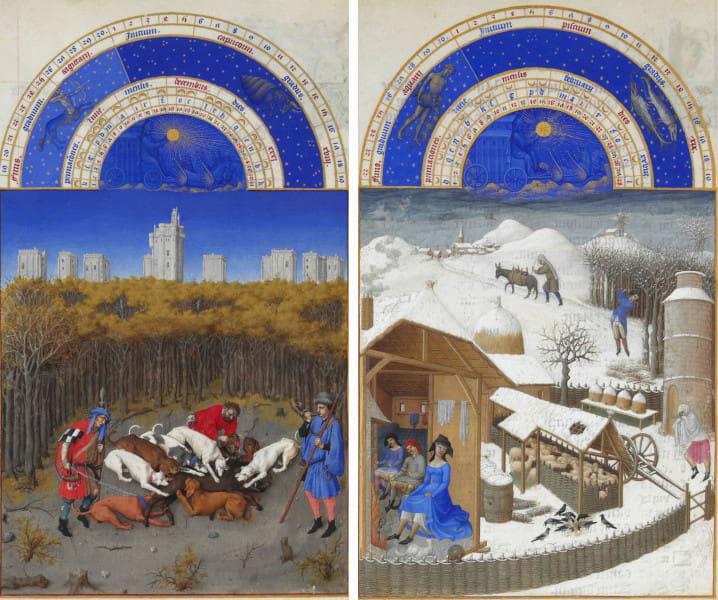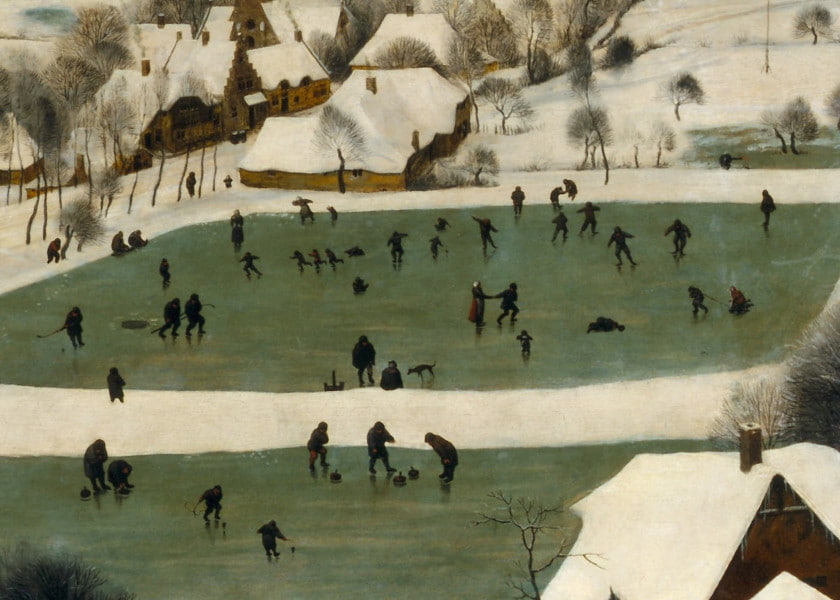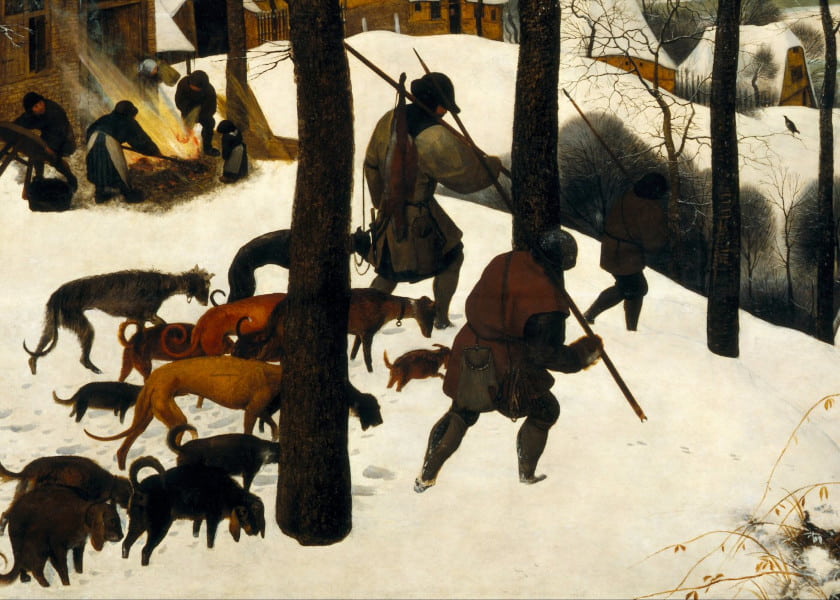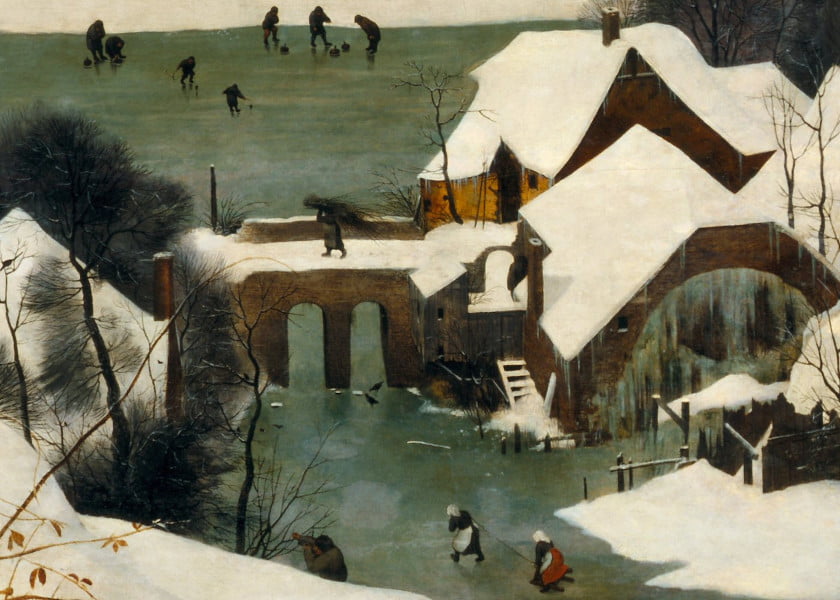Going Inside Pieter Bruegel's Hunters in the Snow
Although considered one of the lower genres in the rigid 19th-century academy-imposed hierarchy of genres in painting, landscapes have entered art history as the genre most easily adopting and adapting to different meanings and symbolism. Presenting a unique fusion of landscape and genre painting, Pieter Bruegel the Elder's Hunters in the Snow represents a timeless masterpiece depicting the harshness of nature.
Bruegel, one of the most famous Dutch and Flemish Renaissance artists, painted the artwork in 1565 as part of a series inspired by the changing seasons. Foremostly a printmaker, Bruegel devoted to painting late in his life, focusing on portraying events from ordinary life and gaining prominence for his peasant scenes. An intricate tribute to everyday life in the bleakness of winter, The Hunters in the Snow, on view at the Kunsthistorisches Museum in Vienna, highlights the position of man in a world dominated by the forces of nature.

The Changing of Seasons
Pieter Bruegel the Elder's most famous series of landscapes resulted from a commission by Niclaes Jonghelinck, a wealthy banker from Antwerp. The paintings depict the months of the year following a Northern European medieval tradition related to Christian prayer books known as Books of Hours. These manuscripts were richly illustrated, the most luxurious being the famous Très Riches Heures du Duc de Berry, created circa 1412 and 1416 by the Limbourg brothers.
Previously appearing as sculptural cycles on churches, the Labours of the Months surfaced in illuminated manuscripts, particularly the calendar pages of books of hours—this set of twelve scenes portrayed rural activities corresponding to each month. The illuminations highly focused on the landscape, which functioned as a precursor for the development of landscape painting in the early Renaissance.
Bruegel's Hunters in the Snow is interpreted as a continuation of the Flemish tradition depicting the months of the year, but the lack of twelve panels has puzzled art historians. Some have theorized that the cycle comprises four paintings portraying the four seasons, implying that Hunters in the Snow represents Winter. With five paintings preserved (The Gloomy Day, The Hay Harvest, The Harvesters, The Return of the Herd, and The Hunters in the Snow), others proposed that the painter followed the twelve-month scheme.
Recently, Bruegel's sketch Spring from 1565 sparked the theory that the painter intended or did create six artworks representing bi-monthly pairs. Following that assumption, Bruegel's masterpiece from the Kunsthistorisches Museum would align with December and January.

The World Landscape
Bruegel's Hunters in the Snow depicts a harsh winter day dominated by the landscape, with various snowy activities dispersed meticulously throughout the scene. Executed primarily in gloomy whites and murky greys, the topography represents a river-cut valley overtaken by the freezing snow with barren, rugged mountain peaks looming in the distance.
The architecture and the frozen ponds point that the Dutch artist partly sought inspiration from the environments of the Netherlands. However, the addition of tall, jagged mountains suggests an imaginary scenery, possibly constructed based on the artist’s encounter with the Alps during his journey to Italy shortly before painting the masterpiece.
Bruegel's masterpiece of the Northern Renaissance, thus, echoes the so-called world landscape, a style of painting that depicts a panoramic view of an imaginary landscape from a high vantage point. The term originates from the German word Weltlandschaft, referring to a type that first emerged in the paintings of the Early Netherlandish painter Joachim Patinir. The composition was quickly adopted by other Dutch and Flemish artists, with Pieter Bruegel the Elder masterfully fusing the world landscape with genre painting.

Hunters in the Snow
Imbued with a plethora of details, Bruegel's Hunters in the Snow demonstrates a complexity of meaning propelled by numerous genre scenes. While some prepare for the cold months, like the figures in front of the inn lighting a fire to singe a pig or a woman carrying sticks across the bridge, others enjoy winter's delights. The frozen surfaces of the river and the ponds provide an ideal setting for a considerable group of figures to ice skate or play winter sports, such as bandy and eisstock, a sport similar to curling.
In the foreground, three hunters and a pack of dogs return from a quest, with some elements suggesting the catch was disappointing. The slumped figures' bodies, the dogs' bowed heads, and a rabbit trail in the snow missed by the hunters form the impression that a single fox on a hunter’s back will not be enough.
The harshness of the winter is further highlighted by details such as the frozen mill or the barren branches inhabited by several crows and a magpie flying across the dreary sky. The magpie particularly underlines the unrelenting quality of the frost since it is often linked with the Devil in European folklore. Thus, crows and magpies surface in Bruegel's paintings as symbols of ill fortune and ill omens, alluding to the severity of the enduring cold and its consequences.

Propelling Change
The first European large-format painting of a winter landscape, Pieter Bruegel the Elder's Hunters in the Snow, is regarded by historians as depicting and documenting the "Little Ice Age" that raged throughout Europe from the 15th until the 19th century. In art history, Bruegel cemented his prominence as a painter who decided to focus on the fusion of landscapes and genre paintings when religious subjects and portraiture were most highly regarded. The painter's choice propelled the next generation of artists to focus on the so-called "lower categories" in the hierarchy of genres, heralding the Dutch Golden Age painting.
Immersing miniature genre scenes into a refined world landscape composition, as in The Hunters in the Snow, demonstrates an all-encompassing overview of the ordinary human. Thus, Bruegel's masterpiece represents a detailed survey of the conditions, everyday activities, and issues in the cold, harsh winter.

Influence in Cinema
The intricacy of The Hunters in the Snow prompted many famous poets, such as William Carlos Williams, John Berryman, and Walter de la Mare, to write ekphrastic poems inspired by the painting as odes to the artist and his icy masterpiece.
Simultaneously, the serenity and the clutter of the winter image have provided a point of departure or appeared as a direct reference in cinema, including films by famous directors, such as Andrei Tarkovsky and Lars von Trier. Pieter Bruegel the Elder's Hunters in the Snow continues to inspire in the Kunsthistorisches Museum in Vienna.
Featured image: Peter Bruegel the Elder – Hunters in the Snow, 1565, detail, Mountains, via Creative Commons.
Can We Help?
Have a question or a technical issue? Want to learn more about our services to art dealers? Let us know and you'll hear from us within the next 24 hours.
